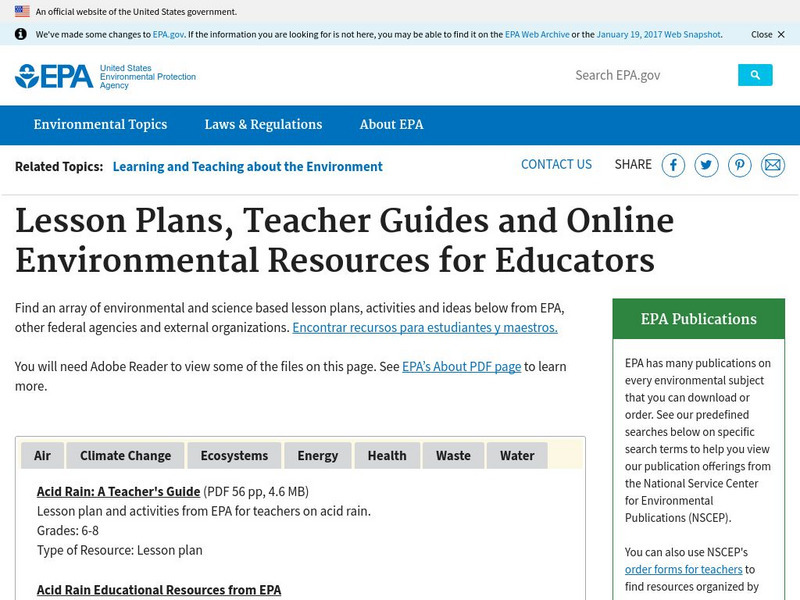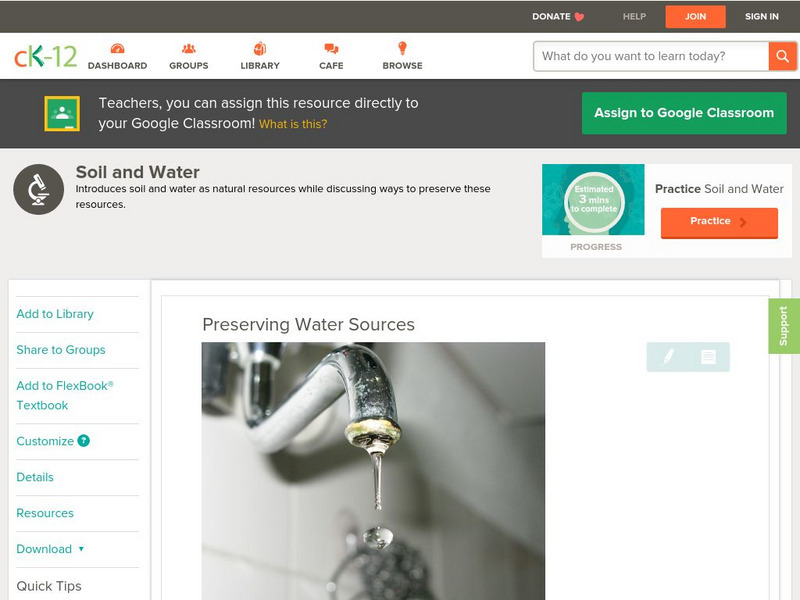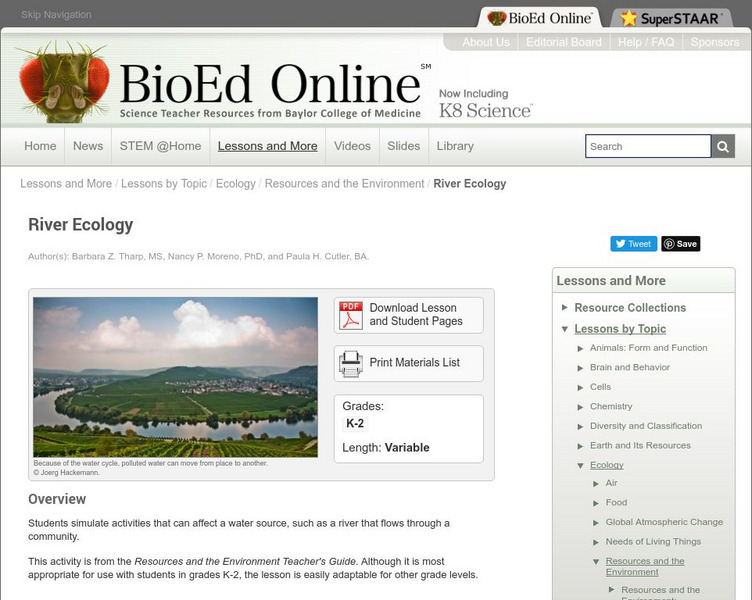Hi, what do you want to do?
Texas Commission on Environmental Quality
Tceq: Lesson Plans & Resources for Teaching Environmental Sciences [Pdf]
A large collection of lesson plans on environmental topics. The lessons are broken up into the broad categories of air, water, and waste, and look at issues around quality, pollution, conservation, and recycling. There are activities for...
US Environmental Protection Agency
Epa: The Water Sourcebooks [Pdf]
This is online resource is for teachers of all grades. The Water Sourcebook contains activities grouped according to grade level. Detailed lesson plans are provided along with glossary and fact sheets.
TeachEngineering
Teach Engineering: Splish, Splash, I Was Takin' a Bath!
In this lesson, students will explore the causes of water pollution and its effects on the environment through the use of models and scientific investigation. In the accompanying activities, they will investigate filtration and aeration...
CK-12 Foundation
Ck 12: Earth Science: Protecting Water From Pollution
[Free Registration/Login may be required to access all resource tools.] Explains why keeping water from being polluted is preferable to cleaning it after being polluted, and what has happened since the passage of the Clean Water Act in...
TED Talks
Ted: Ted Ed: When Is Water Safe to Drink?
Mia Nacamulli examines water contamination and treatment.
US Environmental Protection Agency
Epa: Lesson Plans, Teacher Guides and Online Resources for Educators
Find an array of environmental and science-based lesson plans, activities and ideas from the EPA, other federal agencies, and external organizations.
TeachEngineering
Teach Engineering: How Clean Is That Water?
This lesson plan helps students understand the factors that affect water quality and the conditions that allow for different animals and plants to survive. Students will look at the effects of water quality on various water-related...
PBS
Pbs Learning Media: Environmental Public Health: Human Impact on Water Quality
In this activity, students explore human impact on water resources, investigate the quality of their community's water supply, and consider ways to clean up and avoid further pollution. (Note: Some of the links may no longer work and...
CK-12 Foundation
Ck 12: Life Science: Preserving Water Sources
[Free Registration/Login may be required to access all resource tools.] It might seem like there is plenty of water on Earth, but that's not really the case. Water is a limited resource. That means that it is used faster than it is...
CK-12 Foundation
Ck 12: Biology: Soil and Water Resources
[Free Registration/Login may be required to access all resource tools.] Covers soil and water resources and the threats to these resources.
Other
Museum of Health Care: Death in a Glass
Students can learn all about water pathogens in this online exhibit. They'll explore what kinds of micro-organisms infect water, how a water supply can get contaminated, how it is protected, and how officials investigate cases of...
Alabama Learning Exchange
Alex: Water You Doing to Help?
In this activity from "The Friends of Auntie Litter", (www.auntielitter.org), water pollution will be explored. This activity is one from the "Take Pride Statewide" series. *This activity is provided by Julie Danley, Pam Walston, and Pat...
University of Arizona
Pulse: From Global to City Air: Air Quality, City Design and Disease
Students are challenged to design a healthy city in this unit plan. The cross-curricular unit covers content standards for ninth grade in science, language arts, world geography, and math. Students explore air quality and the impact it...
US Geological Survey
Lake Pontchartrain Basin Foundation: Liquid Assets: Our Water Resources
Lessons designed to show students how water quality, water pollution, and personal lifestyle are related. Lessons help students understand the importance of our water resources and water quality. Students will explore the nonpoint and...
Other
Fnal: Supplying Our Water Needs
A cross-curricular lesson working out needs of a town where fish are dying in the local waters, how can water be purified, how daily activities impact the water supply, and what role does chemistry play in the way individuals use water...
Michigan Reach Out
Reach Out Michigan!: Contaminated Drinking Water
This site is provided for by Reach Out Michigan! Use the site to learn if our eyes and taste buds can detect contaminated drinking water by doing a simple experiment.
BioEd Online
Bio Ed Online: River Ecology
In this lesson plan students are required to simulate activities that can affect a water source, such a river as it flows from one place to another within a community.
Alabama Learning Exchange
Alex: Fred the Fish a Little River Trip
Little River is home to 47 kinds of fish including the threatened "Blue Shiner" Cyprinella caerulea. These fish depend on the good water quality at Little River. This skit allows students to observe pollution's effects on a small scale...
Arizona State University
Arizona State University: Water Survivor Class
Lesson addresses the challenge of supplying clean water during times of a shortage and includes a look at the various water-treatment and filtration processes in place to insure a safe water supply.
Science Education Resource Center at Carleton College
Serc: Healthy Waters
By the end of this lesson, students will understand how we can use macroinvertebrates to determine the quality of water in a river or stream.
SEDL
Oceans [Pdf]
This large PDF file integrates math, science, and language into several lessons about characteristics of the oceans. Topics include ocean currents, tides, density, marine life, and pollution.
CK-12 Foundation
Ck 12: Earth Science: Coastal Pollution
[Free Registration/Login may be required to access all resource tools.] How pollution creates dead zones in the ocean.
CK-12 Foundation
Ck 12: Earth Science: Coastal Pollution
[Free Registration/Login may be required to access all resource tools.] How pollution creates dead zones in the ocean.
HotChalk
Hot Chalk: Lesson Plans Page: Causes of Pollution
This lesson plan is designed to teach young children identify the types of pollution, the sources of the pollution, and how they can protect the environment from further pollutants.





![Tceq: Lesson Plans & Resources for Teaching Environmental Sciences [Pdf] Lesson Plan Tceq: Lesson Plans & Resources for Teaching Environmental Sciences [Pdf] Lesson Plan](https://static.lp.lexp.cloud/images/attachment_defaults/resource/large/FPO-knovation.png)
![Epa: The Water Sourcebooks [Pdf] Lesson Plan Epa: The Water Sourcebooks [Pdf] Lesson Plan](https://content.lessonplanet.com/knovation/original/438669-a5df3fb4e6ba6a238d3d8ad01b4a02a3.jpg?1661258064)

















